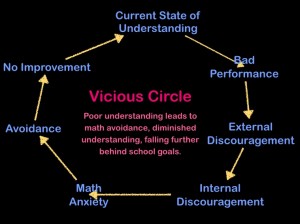At StressLessMath, we offer a complete program intended to give a realistic diagnosis of the causes of an individual’s math anxiety, as well as offer a multi-layered treatment program designed to help diminish its effects. While everyone feels anxious in one way or another when engaging in mathematical tasks, many of us have developed unconscious ways to minimize its affect on our performance. For many people, however, the strategies need to be identified, learned and practiced.
The Two Sources of Math Anxiety
Mathematics anxiety can come from two sources which can be entangled with one another. The first is that the person may be anxious by nature, and mathematics becomes a touchpoint where that kind of feeling can be expressed. This is born out by the research of Dr. Jerome Kagan, who has been examining the development of children with anxious temperaments for over 20 years.

The Vicious Circle Caused By Math Anxiety
Mathematics anxiety can also be a learned response for children who have had negative experiences with math in the home, at school or a combination of the two. As such, math anxiety leads to a cycle of failure, where the student gets negative feedback about his/her performance, which leads to a general dislike and anxiety over learning mathematics.
To effectively treat the debilitating effects of math anxiety, the sources must be investigated and documented. This can be accomplished through interviews and surveys with the student, as well as the people involved in his or her academic and emotional life, including family, caregivers and teachers. In addition, an accurate inventory of a student’s skills must be taken, in order to see if his/her perception of inadequacy is consistent with his/her actual knowledge of mathematics. For many children, there is often a mismatch between their self-assessment of competence and their actual mastery of the subject.
